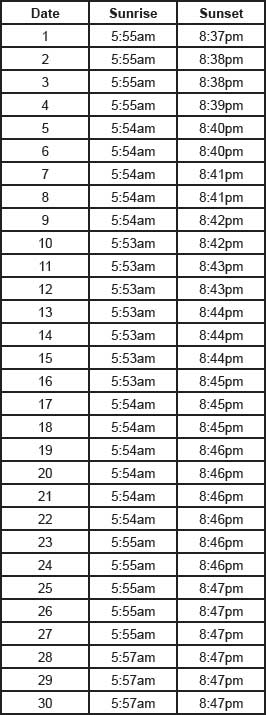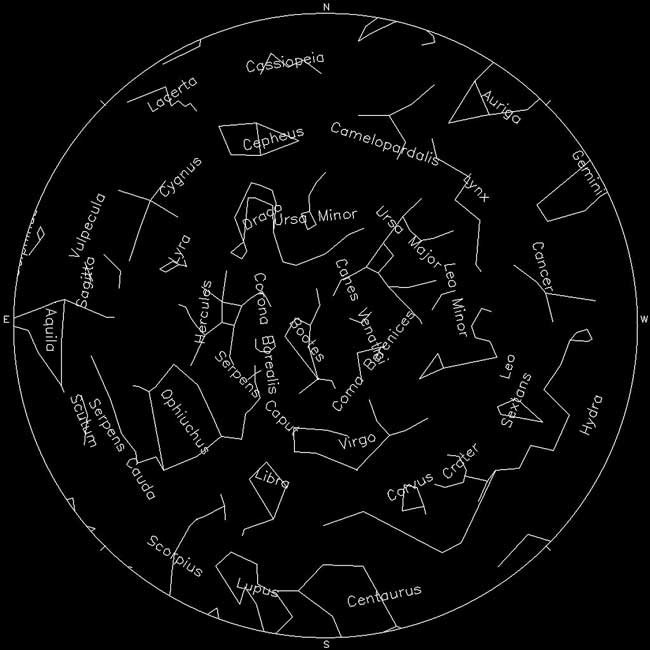Sunrise
and Sunset Times for
June 2008 |
 |
DAYLENGTH
Sunrise and sunset are calculated for a flat horizon. Actual times may vary by one-half hour or more depending upon the terrain. Sunrise varies by only four minutes in June, with the earliest sunrise occurring June 14. Longest day occurs on June 20 even though the earliest sunrise is a week earlier and the latest sunset a week later on June 27. Astronomical twilight begins nearly two hours before sunrise as the sun reaches its northernmost latitude for the year. Nautical twilight begins about one hour before sunrise as color begins to appear in the landscape. Civil twilight begins approximately one-half hour before sunrise when details in the landscape become clearly visible. The reverse progression applies to dusk.
MOON HAPPENINGS
June begins with a waning crescent moon in the early morning sky. New Moon occurs on June 3. On June 7 look low in the western sky for a thin crescent within two degrees of Mars. The next night, June 8, the moon, Saturn, and Regulus cluster within five degrees of one another. Locate Virgo on June 12 as a gibbous moon sits near its bright star Spica. On June 16 the waxing moon passes through Scorpius about one degree from its bright star Antares. A full moon rises on June 18 at 9:15pm. On the next night, June 19, the moon rises with Jupiter at 10:00pm. June closes with a lunar finale before twilight on the morning of June 30. A waning crescent appears in the eastern sky two degrees from the Pleiades star cluster.
METEOR SHOWERS
Look for the blue and white trails of the Lyrid Meteor Shower in mid-June. Meteor activity ranges from June 10 to 21 with peak activity in the early morning hours of Monday, June 16. Find Lyra overhead in the northwest region of the Summer Triangle. A nearly full moon that does not set until after 3:00am could interfere with viewing. Many minor meteor showers occur throughout June in all parts of the sky. Take advantage of the moonless night skies during the first half of the month. Best viewing for meteors is between midnight and 3:00am.
SUMMER SOLSTICE
Summer officially begins in Moab at 5:59pm on June 20 when the sun reaches its highest declination (height) for the year. The change in declination occurs because the earth’s equator is tilted at 23.5 degrees from the plane of its orbit around the sun. Even though the earth is now approaching its farthest point from the sun, the northern hemisphere heats up because its tilted face receives direct sunlight. Since mid-February the angle of the sun in the sky (its declination) has risen rapidly which increases the period of daylight in the northern hemisphere. By early June the increase in the sun’s declination slows. As the earth rounds the elliptical end of its orbit, its motion in space begins to parallel the apparent path of the sun across the sky (the ecliptic). The result is little change in the times of sunrise and sunset during June. Earth’s rotation explains why earliest sunrise and latest sunset do not occur on the solstice when the longest period of daylight occurs. The earth rotates on its axis towards the east which is the same direction it travels in its orbit around the sun. In a 24-hour day from sunrise to sunrise our line of longitude will arrive at the same point in space a little ahead of schedule. The result is earlier sunrises and sunsets before the solstice. After the solstice, the effect of the Earth’s eastward rotation produces later sunrises and sunsets. The latest sunset occurs one week after the solstice. As the sun’s path across the sky drifts back towards the equator, the length of daylight shortens and the effect of later sunsets is no longer noticeable.
VISIBLE PLANETS
Jupiter - rises before midnight in June but still visible in the western sky in early morning twilight;
brightest object in the night sky at -2.7 magnitude.
Mars -
high in the western sky each night moving from Cancer to Leo;
shines (at +1.5 magnitude) nearly as bright as Regulus (+1.36); near Regulus at the heart of Leo by month’s end.
Saturn - in Leo to the east of Regulus; at magnitude +0.8, shines brighter
than Regulus or Mars (to the west of Regulus).
Venus - too close to the sun to be visible as its orbit carries it behind the sun.
Note: Apparent magnitude values range from -4 to +5 for most planets and visible stars. The lower the value the brighter the object.
MAJOR
CONSTELLATIONS OF FEBRUARY |
Overhead
Bootes
Corona Borealis
Hercules
Ophiucus
|
Northward
Cassiopeia
Cepheus
Ursa Major
Ursa Minor
|
Eastward
Aquila
Cygnus
Lyra |
Southward
Libra
Sagittarius
Scorpius
|
Westward
Corvus
Crater
Leo
Virgo |
Bright stars of the summer sky are Spica in Virgo in the western sky; Arcturus overhead in Bootes; Vega (Lyra), Deneb (Cygnus), and Altair (Aquila) form the Summer Triangle in the eastern sky.

Hold the star chart high above
your head and match the compass directions to the direction
you are facing.
Adjust the star chart by orienting Ursa Major (Big Dipper) to match its position
in the sky.
The star chart approximates the
night sky from astronomical twilight to midnight. As the night
and the month progress, the constellations will shift toward
the northwest. |
|

